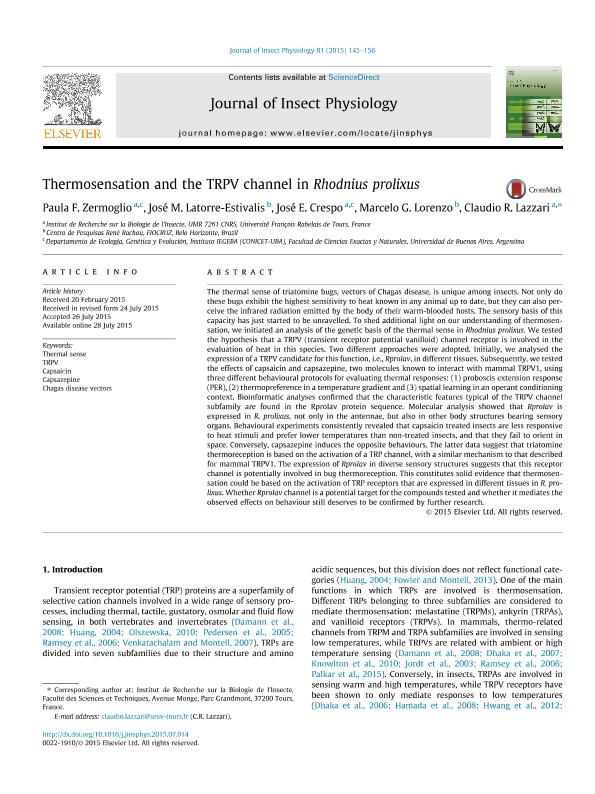Mostrar el registro sencillo del ítem
dc.contributor.author
Zermoglio, Paula Florencia

dc.contributor.author
Latorre Estivalis, Jose Manuel

dc.contributor.author
Crespo, José Emilio

dc.contributor.author
Lorenzo, Marcelo Gustavo

dc.contributor.author
Lazzari, Claudio Ricardo

dc.date.available
2018-06-26T18:41:01Z
dc.date.issued
2015-10
dc.identifier.citation
Zermoglio, Paula Florencia; Latorre Estivalis, Jose Manuel; Crespo, José Emilio; Lorenzo, Marcelo Gustavo; Lazzari, Claudio Ricardo; Thermosensation and the TRPV channel in Rhodnius prolixus; Pergamon-Elsevier Science Ltd; Journal of Insect Physiology; 81; 10-2015; 145-156
dc.identifier.issn
0022-1910
dc.identifier.uri
http://hdl.handle.net/11336/50127
dc.description.abstract
The thermal sense of triatomine bugs, vectors of Chagas disease, is unique among insects. Not only do these bugs exhibit the highest sensitivity to heat known in any animal up to date, but they can also perceive the infrared radiation emitted by the body of their warm-blooded hosts. The sensory basis of this capacity has just started to be unravelled. To shed additional light on our understanding of thermosensation, we initiated an analysis of the genetic basis of the thermal sense in Rhodnius prolixus. We tested the hypothesis that a TRPV (transient receptor potential vanilloid) channel receptor is involved in the evaluation of heat in this species. Two different approaches were adopted. Initially, we analysed the expression of a TRPV candidate for this function, i.e., RproIav, in different tissues. Subsequently, we tested the effects of capsaicin and capsazepine, two molecules known to interact with mammal TRPV1, using three different behavioural protocols for evaluating thermal responses: (1) proboscis extension response (PER), (2) thermopreference in a temperature gradient and (3) spatial learning in an operant conditioning context. Bioinformatic analyses confirmed that the characteristic features typical of the TRPV channel subfamily are found in the RproIav protein sequence. Molecular analysis showed that RproIav is expressed in R. prolixus, not only in the antennae, but also in other body structures bearing sensory organs. Behavioural experiments consistently revealed that capsaicin treated insects are less responsive to heat stimuli and prefer lower temperatures than non-treated insects, and that they fail to orient in space. Conversely, capsazepine induces the opposite behaviours. The latter data suggest that triatomine thermoreception is based on the activation of a TRP channel, with a similar mechanism to that described for mammal TRPV1. The expression of RproIav in diverse sensory structures suggests that this receptor channel is potentially involved in bug thermoreception. This constitutes solid evidence that thermosensation could be based on the activation of TRP receptors that are expressed in different tissues in R. prolixus. Whether RproIav channel is a potential target for the compounds tested and whether it mediates the observed effects on behaviour still deserves to be confirmed by further research.
dc.format
application/pdf
dc.language.iso
eng
dc.publisher
Pergamon-Elsevier Science Ltd

dc.rights
info:eu-repo/semantics/openAccess
dc.rights.uri
https://creativecommons.org/licenses/by-nc-nd/2.5/ar/
dc.subject
Capsaicin
dc.subject
Capsazepine
dc.subject
Chagas Disease Vectors
dc.subject
Thermal Sense
dc.subject
Trpv
dc.subject.classification
Otras Ciencias Biológicas

dc.subject.classification
Ciencias Biológicas

dc.subject.classification
CIENCIAS NATURALES Y EXACTAS

dc.title
Thermosensation and the TRPV channel in Rhodnius prolixus
dc.type
info:eu-repo/semantics/article
dc.type
info:ar-repo/semantics/artículo
dc.type
info:eu-repo/semantics/publishedVersion
dc.date.updated
2018-06-26T13:45:07Z
dc.journal.volume
81
dc.journal.pagination
145-156
dc.journal.pais
Estados Unidos

dc.description.fil
Fil: Zermoglio, Paula Florencia. Université François Rabelais de Tours; Francia. Consejo Nacional de Investigaciones Científicas y Técnicas. Oficina de Coordinación Administrativa Ciudad Universitaria. Instituto de Ecología, Genética y Evolución de Buenos Aires. Universidad de Buenos Aires. Facultad de Ciencias Exactas y Naturales. Instituto de Ecología, Genética y Evolución de Buenos Aires; Argentina
dc.description.fil
Fil: Latorre Estivalis, Jose Manuel. Fundación Oswaldo Cruz; Brasil. Consejo Nacional de Investigaciones Científicas y Técnicas; Argentina
dc.description.fil
Fil: Crespo, José Emilio. Université François Rabelais de Tours; Francia. Consejo Nacional de Investigaciones Científicas y Técnicas. Oficina de Coordinación Administrativa Ciudad Universitaria. Instituto de Ecología, Genética y Evolución de Buenos Aires. Universidad de Buenos Aires. Facultad de Ciencias Exactas y Naturales. Instituto de Ecología, Genética y Evolución de Buenos Aires; Argentina
dc.description.fil
Fil: Lorenzo, Marcelo Gustavo. Fundación Oswaldo Cruz; Brasil
dc.description.fil
Fil: Lazzari, Claudio Ricardo. Université François Rabelais de Tours; Francia. Consejo Nacional de Investigaciones Científicas y Técnicas; Argentina
dc.journal.title
Journal of Insect Physiology

dc.relation.alternativeid
info:eu-repo/semantics/altIdentifier/doi/http://dx.doi.org/10.1016/j.jinsphys.2015.07.014
dc.relation.alternativeid
info:eu-repo/semantics/altIdentifier/url/https://www.sciencedirect.com/science/article/pii/S0022191015001626
Archivos asociados
